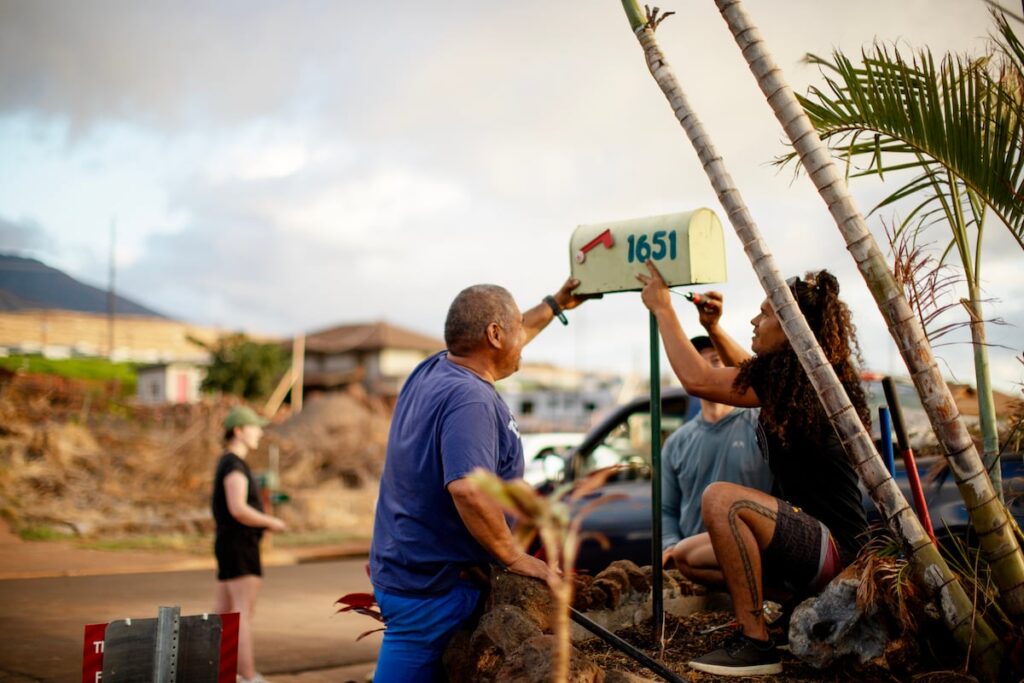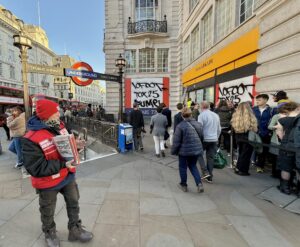The Rise of Group Land Trusts in Hawai‘i

This story was co-published with Overstory, a web based newsroom protecting the techniques and options behind Hawai‘i’s most urgent points.
On Aug. 8, 2024, a brand new milestone was reached within the aftermath of the lethal Lahaina wildfire that destroyed 2,200 buildings and displaced 12,000 residents on the island of Maui: A Lahaina nonprofit secured its first residential parcel for neighborhood possession.
1651 Lokia Road, which as soon as held a four-bed, three-bath home, sits empty. However someday, the property will accommodate a brand new predominant home and two accent dwelling items — identified domestically as ‘ohana items — offering a steady, reasonably priced residence for an prolonged or multigenerational household.
That property will perpetually stay within the arms of Lahaina’s individuals underneath the Lahaina Group Land Belief, which can personal the land and solely promote properties atop to long-term native residents.

Lokia Road will perpetually stay within the arms of Lahaina’s individuals underneath the Lahaina Group Land Belief, which can personal the land and solely promote properties atop to Lahaina residents. (Photograph by LCLT)
Lahaina residents have lengthy pushed again towards exterior actual property pursuits and had been already coping with displacement earlier than the hearth. However amid a worsened housing scarcity, rising rents and speculators trying to money in on the tragedy, securing Lahaina and safeguarding reasonably priced properties for its neighborhood members has grow to be extra vital than ever. A March 2024 report estimated that, with out intervention, as a lot as 20% of Lahaina’s housing provide might change arms within the subsequent three years.
“I can’t even start to quantify the affect of securing one piece of property that till perpetually goes to deal with how many individuals,” says Autumn Ness, govt director of the Lahaina Group Land Belief. “You possibly can’t be evicted. What number of households are going to get pleasure from that and be higher neighborhood members for it? As a result of they’ve a roof over their head, their youngsters may have current mother and father.”
The nonprofit is one among a number of Hawai‘i neighborhood land trusts which have been established lately as land safety specialists, neighborhood organizers, actual property professionals and others look to fight Hawai‘i’s ever-increasing housing costs, preserve extra longtime residents of their communities and protect Hawai‘i’s tradition and identification.
In 2023, Gov. Josh Inexperienced declared Hawai‘i’s reasonably priced housing scarcity an emergency. Hawai‘i has the very best median residence gross sales value within the nation and hasn’t been constructing sufficient properties for many years. The disaster disproportionately impacts Native Hawaiians, who’re overrepresented among the many state’s houseless inhabitants and have the next poverty charge than different main ethnic/race teams.
“What household in Hawai‘i isn’t frightened about their kids’s means to be right here, about their kids’s means to be near them as they age, that they’ll have the ability to know their grandchildren?” says Carolyn Auweloa, chief operations officer of the Lahaina Group Land Belief.
With a excessive charge of out-of-state homeownership — in 2023, out-of-state patrons represented 21% of the single-family residence transactions and 27% of the condominium transactions — Hawai‘i’s properties are sometimes commodified as instruments to construct particular person wealth. The area people land trusts hope to vary the narrative round housing in paradise by emphasizing collective, moderately than particular person, well-being.
Meaning embracing that steady, reasonably priced housing can strengthen households and communities when residents don’t must work two or three jobs to get by.
“The massive paradigm shift that we attempt to deliver individuals throughout is to cease fascinated by actual property as a wealth-building car and see it as an alternative as a neighborhood asset,” Auweloa says. “It doesn’t matter how a lot housing we create, there’ll all the time be this insatiable demand for it as a result of it’s so fascinating to be right here.”
A type of collective stewardship
Group land trusts are one type of collective stewardship. Hawai‘i is aware of that mannequin properly, given that every one land as soon as belonged to the highest-ranking chief and was collectively cared for by maka‘āinana, or commoners.
After the Nice Māhele of 1848 started implementing non-public landownership, some Native Hawaiians and different Kingdom of Hawai‘i residents shaped land huis to collectively buy and steward land. In 1869, a hui of 71 Native Hawaiians and different Kingdom residents bought virtually the whole 15,000-acre land division of Wainiha on Kaua‘i, in response to a 2012 article within the College of Hawai‘i Legislation Evaluate. Six years later, 38 Native Hawaiian Hā‘ena households collectively bought the neighboring ahupua‘a of Hā‘ena.
“The neighborhood land belief and the hui are simply two examples of how our society has grappled with this damaged system that has by no means actually labored — of personal property possession and that non-public property possession equals the appropriate for somebody to make use of property to construct their particular person wealth,” Ness says.

After signing the paperwork to safe its first parcel for neighborhood possession on Aug. 8, 2024, Lahaina Group Land Belief held a blessing for the land. (Photograph courtesy LCLT)
Group land trusts are highly effective mechanisms for stopping communities of coloration from being displaced. The first neighborhood land belief within the U.S. originated within the southern U.S. Civil Rights Motion within the late Nineteen Sixties to create a brand new type of land tenure for Black farmers.
Group land trusts are nonprofits that personal land on behalf of a place-based neighborhood and promote or hire the properties on high. They’re typically ruled by a board of land belief residents, broader neighborhood residents and public representatives.
They make their land obtainable to owners by renewable floor leases that usually final 99 years. By proudly owning the land and limiting the worth at which properties may be bought for, they make the price of homeownership extra accessible to a wider section of the neighborhood, together with these with restricted means, and defend the properties from hypothesis.
There are 314 neighborhood land trusts throughout 46 states, D.C. and Puerto Rico, in response to a 2022 census by the Lincoln Institute of Land Coverage, a nonprofit suppose tank, and the Grounded Options Community, a nationwide nonprofit that advances completely reasonably priced housing options. These neighborhood land trusts maintain almost 44,000 completely reasonably priced housing items.
Jason Webb helps neighborhood teams across the nation begin neighborhood land trusts as a neighborhood and technical help principal on the Grounded Options Community. He says neighborhood land trusts are a rising mannequin that tends to comply with scorching actual property markets the place lower-income people have been priced out. Extra neighborhood land trusts are additionally being created in Indigenous communities and within the wake of pure disasters.
And whereas lots of the nation’s earlier land trusts had been began by neighborhood activists and organizers, he’s now seeing many be began by professionals, resembling these working in actual property, enterprise and foundations.
Taylor Kaluahine Lani, chief working officer and co-founder of Kaua‘i nonprofit Completely Inexpensive Dwelling Hawai‘i, says neighborhood land trusts are a culturally competent mannequin for homeownership in Hawai‘i as a result of they redefine wealth as household and neighborhood wellbeing.
Lani grew up on the island’s North Shore and have become an actual property agent upon returning after school. Locals, she says, have a tendency to remain in place as soon as they’ve discovered their piece of property, constructing additions in the event that they want more room, and embrace having a long-term residence base the place their households can have safety. That’s a distinct mentality than utilizing their properties to maneuver to completely different neighborhoods, counties and even out of Hawai‘i to climb the financial ladder.
“We nonetheless can construct wealth with out contributing to that displacement,” Lani says. PAL Hawai‘i launched its Ho‘omaluhia Group Land Belief in 2024 and has to date positioned 5 properties underneath building in its Kauhale O Namahana mission into that belief. The Kīlauea mission will ultimately include 11 properties. PAL can be constructing initiatives in Kalāheo and Waipouli.

Kaua‘i nonprofit Completely Inexpensive Dwelling Hawai‘i has to date positioned 5 under-construction properties into its Ho‘omaluhia Group Land Belief. The mission will serve households incomes 120% of the realm median revenue and under. (Photograph courtesy PAL Hawai‘i)
Completely reasonably priced housing
Carrie DeMott was educating in West Maui when she heard in regards to the Nā Hale O Maui neighborhood land belief from a fellow educator. She was renting and determined to undergo its four-step qualification course of as a result of she felt she “wanted to be doing one thing in direction of getting steady housing” for her younger son.
About seven years in the past, sewage from her bathe overflowed all through her rental. Seeing her son making an attempt to choose up a sewage-covered ebook he had been gifted from his nana was a wake-up name.
“I scooped him up, and I used to be identical to, what? Oh, my God. Like, how am I right here?” she says. “I did every little thing proper. I went to varsity. I paid off my loans. I’m working as a trainer. I’m giving my coronary heart and soul to the neighborhood, and right here I’m, and I’m on this horrible home, and my child’s books are coated in sewage..”
She was ecstatic when she was chosen to buy a house from Nā Hale O Maui and went on to function a resident member of the group’s board to assist be a voice for owners. She’s now the nonprofit’s interim govt director.

Jen, Kūmoanaākea, Richard, and Keolaonākai’elua on the key presentation of their new Wailuku residence. Nā Hale O Maui has bought 50 single-family, leasehold properties to 57 households because it was based in 2006. (Photograph by Rylee Sparling, KSM 2026 / Nā Hale O Maui)
Based in 2006, Nā Hale O Maui is the longest-running neighborhood land belief within the state and has 50 properties in its belief. Dave Ward, a founding member and present board member, says the neighborhood land belief stemmed from a various group of people — together with actual property professionals, an lawyer, a county council member, a planning fee member and others — who needed to deal with the island’s rising housing affordability hole.
The Nice Recession started shortly after the group was shaped, so its early years had been spent buying and rehabilitating empty, foreclosed properties. It’s continued to purchase present properties, along with constructing on empty heaps. Just a few of these already-built properties had been donated in-kind from the county, and the county has additionally donated heaps for the land belief to construct on.
Nā Hale O Maui has bought leasehold properties in Kīhei, Kahului, Wailuku, Lahaina and Makawao at below-market costs, and, like many land trusts, its resale costs are decided utilizing a system to protect affordability for low- to moderate-income households in perpetuity.
That system considers the preliminary buy value, the house owner’s share of appreciation, any capital enhancements that the house owner did, and whether or not the house has suffered extreme injury or neglect. The house owner’s share of appreciation ranges from 25% to 50%, relying on how lengthy the house owner stayed within the residence.
“It’s like for those who had been going to speculate cash in a cash market, perhaps a excessive yield financial savings account, or one thing like that,” DeMott says. “You’re not going to come out of this like with a windfall.”
DeMott and Ward acknowledge that this mannequin isn’t for everybody, nevertheless it has helped two households transfer into market-rate properties.
In line with Webb, owners keep in a neighborhood land belief residence for a mean of 10 years, although many organizations encourage owners to remain longer, even for a number of generations.
It’s in regards to the individuals of a spot
Within the northwestern nook of Hawai‘i Island, Kohala is famend for being the birthplace of King Kamehameha I and a coaching middle for his military. It’s additionally well-known for its plantation roots, which introduced within the Filipino, Japanese, Chinese language and Portuguese households that, together with Native Hawaiians, have lengthy made up the neighborhood.
Ashton Dircks is a seventh-generation taro farmer, former archaeologist and present highschool trainer who was raised in Kohala. He recollects the times when everybody knew one another and the way he couldn’t go down the street with out waving at virtually each automotive. That wasn’t the case when he returned residence about eight years in the past.

The Kohala Group Land Belief’s first annual membership assembly in January drew a full home. The nonprofit is concentrated on buying plantation-era Kohala properties. (Photograph by Rascha Jelks / KCLT
“I didn’t acknowledge any of the automobiles on the street or the individuals driving these automobiles,” he says. “I am going to the put up workplace, and I felt like I used to be a minority within the city I grew up in.”
Now the chair of the Kohala Group Land Belief’s board, he hopes to provide Kohala residents an opportunity to remain and thrive in the neighborhood.
“It’s the individuals who make the place, and with out these people who find themselves Kohala, Kohala is simply not the identical,” Dircks says. “And this land belief, I noticed this as a car to attempt to get Kohala individuals again.”
Kohala residents had been looking for a community-led housing resolution since 2000. The Kohala Group Land Belief was initially shaped in 2003, however an absence of funding brought on it to dissolve in 2006. The land belief’s present iteration was born in 2023 from conversations among the many 2008 North Kohala Group Growth Plan’s reasonably priced housing group.
Kohala has seen restricted reasonably priced housing growth. One problem is that almost all of Kohala is zoned for agriculture and requires that constructing websites be a minimum of 20 acres, says Beth Robinson, board secretary of the Kohala Group Land Belief and one among eight North Kohala residents who helped revitalize the nonprofit.
The group hopes to accumulate plantation-era properties on smaller plenty of about 10,000 or 15,000 sq. toes, moderately than constructing new ones. Robinson, who can be an actual property dealer and director of conservation and legacy lands at Hawai‘i Life, says that of the 203 properties bought for underneath $400,000 between 2009 and 2024, 73% went to Kohala or close by residents and 27% went to outsiders.
“Whereas it wasn’t as unhealthy as all of us thought, as a result of we’re saying that just about three-quarters of the properties didn’t go to outsiders, 55 properties did,” Robinson says. “In order that’s the place we sort of got here up with this mannequin of each residence that we don’t lose to an outsider is a house that we don’t must construct.”
The land belief obtained its 501(c)3 standing in August. It spent the autumn getting enter from neighborhood teams and held its first annual membership assembly in January. Its committees are actually serving to the belief decide what properties to accumulate and what insurance policies it ought to comply with, and it hopes to safe its first property by the tip of 2025.
Born within the aftermath of catastrophe
The Lahaina Group Land Belief goals to buy destroyed parcels from Lahaina residents who don’t wish to rebuild however nonetheless wish to see the land stay with the neighborhood.
“What the neighborhood land belief resolution presents is a giant ‘and,’ ” Auweloa says. “They will get what they should transfer on, if that’s their alternative, if that’s what they should do. And so they can commit their land in a means that’s good for the long run and is sweet for the neighborhood, and it will probably even embrace them sooner or later.”
Auweloa grew up in Lahaina and spent 22 years working with the U.S. Division of Agriculture. A lot of these years had been spent on Hawai‘i Island, the place she would work on conservation and agricultural easements.
“It was that perspective and that have that impressed, within the wake of the hearth and the worry of the land grabs, that there should be a way that we might put some sort of safety on land that may protect it for a neighborhood, for individuals,” she says.
Lahaina was as soon as the capital of the Hawaiian Kingdom. It grew to become a worldwide whaling and buying and selling middle earlier than transitioning right into a quiet sugar plantation city after which a serious vacationer vacation spot. Consequently, Lahaina residents had been already seeing their neighborhood rework lengthy earlier than the 2023 fires as increasingly newcomers, particularly rich retirees, moved in and working-class residents moved out.
Auweloa says it was vital to the group’s founders that its govt and advisory boards be deliberately composed of people with deep Lahaina roots, given Hawai‘i’s historical past of stolen lands and unmet guarantees to offer reasonably priced housing. Many are ‘āina specialists — people who’ve lengthy histories of defending water, ‘āina and Hawaiian tradition.
“We’re deliberately completely different,” she says. However she famous that she is seeing extra neighborhood members who used housing for wealth era perceive that it’s about household and neighborhood wellbeing.
The sellers of the Lahaina Group Land Belief’s first acquisition, for instance, returned to the continent and bought their property to the land belief as a result of they didn’t wish to contribute to the additional displacement of Native Hawaiians and exploitation of Hawai‘i’s lands by exterior pursuits.
The belief has to date acquired 5 parcels and is 12 others. Along with buying land, it additionally plans to make use of perpetual “kama‘āina easements” to require that properties it assists in different methods be bought solely to Lahaina residents if they modify arms. And the land belief will probably be provided the property first.
The kama‘āina easements will probably be used for the group’s insurance coverage hole pilot program, which can assist Lahaina residents rebuild their properties. Ness, the group’s govt director, estimates that the common hole for underinsured residents is about $400,000.
Ness beforehand labored in housing coverage and says that the county’s common per-unit subsidy over the past decade was about $350,000. However as a result of these properties solely keep reasonably priced for 5 to 10 years, they solely assist one house owner. As compared, the land belief’s funding of $400,000 will end in a completely reasonably priced residence.
Increasing Hawai‘i’s neighborhood land trusts
There are six energetic neighborhood land trusts in Hawai‘i. State Rep. Tina Nakada Grandinetti says with Hawai‘i experiencing a lot displacement, many residents are hungry for a way of management over what occurs to their properties and neighborhoods.
This legislative session, she launched two payments that intention to encourage the growth of neighborhood land trusts and forestall the lack of foreclosed properties to second homebuyers and residential buyers.
HB 833 would create a five-year pilot program underneath the Hawai‘i Housing Finance and Growth Company to offer neighborhood land trusts with a line of credit score to assist them present reasonably priced properties. And HB 467 would prohibit sellers of foreclosed properties from bundling properties at a public sale and permit neighborhood land trusts 45 days to match or beat the most effective public sale bid to purchase the property. HB 467 is lifeless for this session, however its Senate Companion, SB 332, remains to be transferring ahead.
Within the meantime, Nā Hale O Maui has bought properties to 57 households — instantly impacting properly over 100 kids. DeMott says she is aware of fairly just a few academics who’re nonetheless educating on Maui due to the group, and the newest households included cops and firefighters.
“It retains the those that do neighborhood service-based work right here,” she says. And the group’s homebuyer schooling has helped many households grow to be extra educated about reasonably priced housing and what sources can be found.
In Lahaina, the Lahaina Group Land Belief is growing a weighted lottery system that it’ll use to decide on owners for its properties. The plan is to prioritize Lahaina neighborhood members primarily based on how lengthy they lived within the city, to make sure the properties go to these with deep ties to the neighborhood. Maui County already permits for workforce housing candidates — each for possession and rental items— to be chosen by lottery after which be ranked by the overall size of time every has been a resident of the County.
“We are able to truly make a system that favors our neighborhood, so hopefully it’ll normalize the dialog somewhat bit as we do it,” Ness says.
She and Auweloa say each property that the Lahaina Group Land Belief finds an answer for is a win that they’re pleased with. The land belief’s purpose is to guard 20% of Lahaina’s properties.
“I’d written off ever having the ability to dwell right here,” Auweloa says. “… I’m stoked that we’re beginning one thing right here that’s solely going to achieve momentum and goes to imply a brand new final result for a lot of households for Lahaina.”






